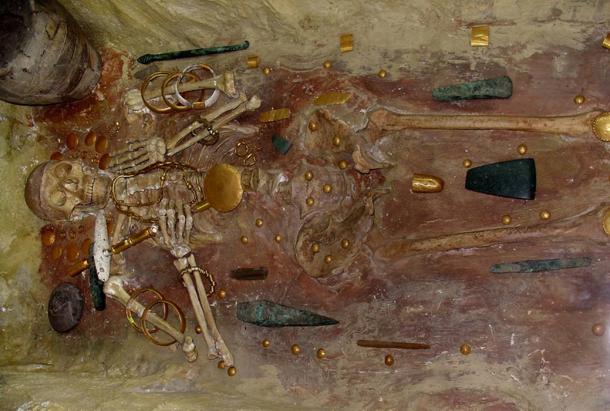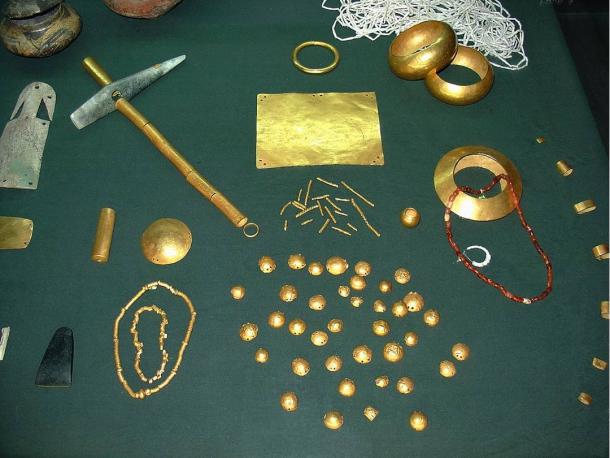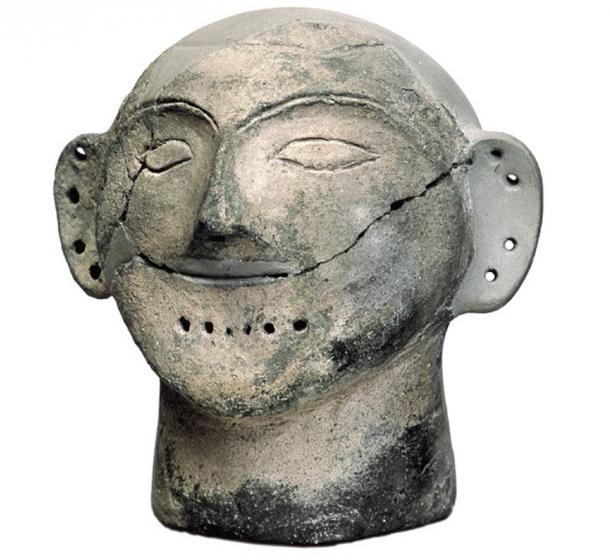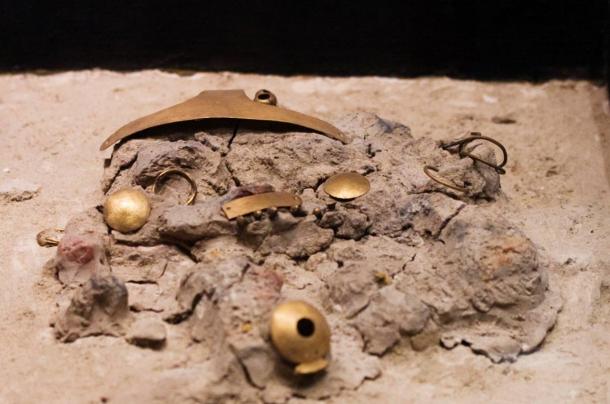
Varna Man and the Wealthiest Grave of the 5th Millennium BC
In the 1970s, archaeologists in Bulgaria stumbled upon a vast Copper Age necropolis from the 5th millennium BC containing the oldest golden artifacts ever discovered near the modern-day city of Varna. But it was not until they reached grave 43 that they realized the real significance of the finding. Inside burial 43 they unearthed the remains of a high status male buried with unfathomable riches – more gold was found within this burial than in the entire rest of the world in that period.
Most people have heard of the great civilizations of Mesopotamia, Egypt, and the Indus Valley, which are all noted for being the earliest known civilizations to feature urbanization, organized administration, and cultural innovation. But few have heard of the mysterious civilization that emerged on the shores of lakes near the Black Sea some 7,000 years ago.
The Amazing Varna Culture
The Varna culture, as it has come to be known, was not a small and inconsequential society that emerged in a little corner of what would become Bulgaria and disappeared quickly into the pages of history. Rather, it was an amazingly advanced civilization, more ancient than the empires of Mesopotamia and Egypt, and the first known culture to craft golden artifacts.
Varna is also now home to the largest known prehistoric necropolis in south-eastern Europe, which reflects a richness in cultural practices, complex funerary rites, an ancient belief system, and the capacity to produce exquisite and expertly-crafted goods. It has come to be known as the cradle of civilization in Europe.

The Varna man burial has some of the world's oldest gold jewelry. (Yelkrokoyade/CC BY SA 3.0)
The Rise of Goldsmithing and Wealth
Evidence suggests that it was between 4600 and 4200 BC when goldsmithing first started in Varna. As advances were made, and craftsmen mastered metallurgy of copper and gold, the inhabitants now had something extremely valuable to trade. Increased contacts with neighbors in both the north and south eventually opened up trade relations within the Black Sea and Mediterranean region, which was of great importance for the development of the society. The deep bay, along which the settlements of Varna, provided a comfortable harbor for ships sailing across the Black Sea and Varna became a prosperous trading center.
Increased trading activity allowed the metallurgists to accumulate wealth, and very quickly a societal gap developed with metallurgists at the top, followed by merchants in the middle, and farmers making up the lower class. Incredible discoveries made at a nearby cemetery also suggest that Varna had powerful rulers or kings – but we will come back to that.
And so, the foundations had been laid for the emergence of a powerful and flourishing culture, whose influence permeated the whole of Europe for thousands of years to come.
Discovering The Ancient Varna Civilization
The first evidence of Varna’s ancient civilization came in the form of tools, vessels, utensils, and figurines made from stone, flint, bone, and clay. Then an incredible chance discovery came to light, that made headlines around the world. In October, 1972, excavator operator Raycho Marinov stumbled upon a vast Copper Age necropolis containing the oldest gold artifacts ever discovered.
It was to become one of the most important archaeological discoveries ever made in Bulgaria. Extensive excavations were launched under the direction of Mihail Lazarov (1972–1976) and Ivan Ivanov (1972–1991), revealing for the first time the magnificent civilization of Varna.
More than 300 graves were uncovered in the necropolis, and between them over 22,000 exquisite artifacts were recovered, including 3,000+ items made from gold - with a total weight of 6 kg (13.23 lbs.) Other precious relics found within the graves included copper, high-quality flint tools, jewelry, shells of Mediterranean mollusks, pottery, obsidian blades, and beads.

Golden objects found in the necropolis. (Yelkrokoyade/CC BY SA 3.0)
Analysis of the graves revealed that the Varna culture had a highly structured society – elite members of society were buried in shrouds with gold ornaments sewn into the cloth wrappings and their graves were laden with treasures, including gold ornaments, heavy copper axes, elegant finery, and richly decorated ceramics, while others had simple burials with few grave goods.
The Richness of Grave 43
While there were many elite burials uncovered, there was one in particular that stood out among the rest – grave 43. Inside grave 43, archaeologists uncovered the remains of a high status male who appears to have been a ruler/leader of some kind. More gold was found within this burial than in the entire rest of the world in that period. The male, who became known as the Varna man, was buried with a scepter – a symbol of high rank or spiritual power – and wore a sheath of solid gold over his penis.
The burial is incredibly significant for more than just the grave goods - it is the first known elite male burial in Europe. Prior to this, it was women and children who received the most elaborate burials.
Marija Gimbutas, a Lithuanian-American archaeologist, who was well-known for her claims that Neolithic sites across Europe provided evidence for matriarchal pre-Indo-European societies, suggested that it was the end of the 5th millennium BC when the transition to male dominance began in Europe. Indeed, in the Varna culture, it was observed that around this time men started to get the better posthumous treatment.
Complex Funerary Rites in the Varna Necropolis
The burials in the Varna necropolis have also offered a lot more than the precious artifacts found within them and discoveries relating to social hierarchies; the features of the graves have also provided key insights into the religious beliefs and complex funerary practices of this ancient civilization.
It became apparent to researchers that the males and females were laid out in different positions within the graves – males were laid out on their backs, while females were placed in a fetal position. But most surprising of all was the discovery that some graves contained no skeleton at all, and these ‘symbolic graves’ were the richest in terms of the amount of gold and other treasures found within them. Some of these symbolic graves, or cenotaphs, also contained human-sized masks made of unbaked clay placed in the position where the head would have been.

Human-sized clay head found at Varna necropolis. (CC BY SA 4.0)
The graves containing the clay masks were also found to contain gold amulets in the shape of women placed in the position where the neck would have been. These amulets, associated with pregnancy and childbirth, indicate that the 'burials' were meant for females. Further evidence of this is the fact that there were no battle-axes found in these cenotaphs, but each of them had a copper pin, a flint knife, and a spindle whorl.

Replica of a symbolical burial of an antropomorphous face made from clay. The original was found at the Varna Chalkolithic Necropolis (grave 2) and dates to the fourth millennium BC. (Ann Wuyts/CC BY 2.0)
The Downfall and Legacy of the Varna Culture
By the end of the fifth millennium BC, the once strong and powerful Varna culture began to disintegrate. It has been hypothesized that the downfall of the Varna civilization was the result of a combination of factors including climate change, which turned large areas of arable land into marshes and swamps, as well as the incursion of horse-riding warriors from the steppes.
- Golden Varna Plate Linked To Daring Sea Voyage Between Black Sea and Egypt 7,000 Years Ago
- Giant Human Skeleton unearthed in Varna, Bulgaria
- Oldest known Gold Jewelry in Europe Discovered at Bronze Age Bulgarian site
Although the Varna civilization did not leave any direct descendants, the members of this ancient culture did leave behind many lasting legacies and set the stage for the emergence of subsequent civilizations throughout Europe. Their skills in metallurgy were unprecedented in Europe and indeed throughout the world, and their society demonstrated many features of a highly advanced and developed civilization.
They also developed the societal structure of a centralized authority – a person or institution to monitor and ensure the proper functioning of the society. All the fundamental principles of modern society had been found – a model of civilization that we still follow to this day.
Top Image: Grave 43 – an elite male burial found at the Varna Copper Age necropolis. Source: Yelkrokoyade/CC BY SA 3.0
Updated on August 20, 2020.
References:
Avramova, M. 2000. Myth, ritual and gold of a “civilization that did not take place”. – In: Varna Necropolis. Varna, Agató, 15-24.
Chapman, J., T. Higham, B. Gaydarska, V. Slavchev, N. Honch. 2006. The social context of the emergence, development and abandonment of the Varna Cemetery, Bulgaria. European Journal of Archaeology, Vol. 9, No. 2-3, 159-183.
Dimitrov, D. & Georgiev, G. (2011). Black Sea coast as cradle of first civilizations. Current Archaeology Research in Bulgaria. Available from: http://berberian11.tripod.com/dimitrov_postprocession.htm
Linehan, C. (2012). The victorious Varna culture. The History of Europe Podcast. Available from: http://thehistoryofeuropepodcast.blogspot.com.au/2012/05/victorious-varna-culture.html
Norman A. (2003). The Oldest Gold in the World in a Varna Cemetery. ANISTORITON: ArtHistory Volume 7, September 2003: Available from: http://www.anistor.gr/english/enback/o033.htm
Varna Museum of Archaeogy. Available from: http://www.amvarna.com/eindex.php?lang=2&lid=2&slid=&slid=1
















Comments
“...and wore a sheath of solid gold over his penis.” Really? Hmmm, but even mummified, shrunken and shrivelled, ...maybe there’s another explanation.
Nobody gets paid to tell the truth.
How many more Varnas are yet to be found, buried and forgotten...
From stardust I was born, to stardust I shall return
Many of the gold objects found on site have specific measurements, that connect the Pi and Fibonaci numbers, which suggests they knew a lot of things we forgot. And in my opinion, this civilization did not go extinct - it moved after the Black sea flood. They were called by different names, but in the end, they still live there.
I'd love to see more on the DNA profile of the Varna people and how it connects with other ancient tribes. Nice job sneaking in the last line: " – and wore a sheath of solid gold over his penis." I had a good laugh at this. Suffice it to say that he could be the original Goldmember. Austin Powers eat your heart out.
Yes. If i were you. Perhaps go to where a lady, self taught archeologist is looking for Cleopatra at her ancient palace. I forget her name.
Pages